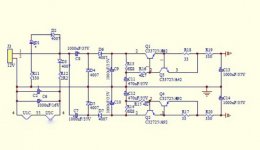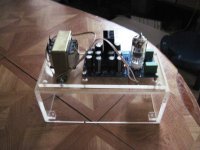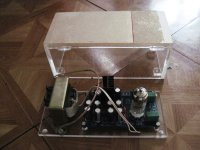A mains fuse is only put there for safety.nope not for this size, if u use a teeny tiny fuse then you are just protecting the transformer not providing safety............
I contacted the vendor and asked if I could put a 20VA transformer, but he said it has to be at least 30VA, so I guess this is what I will go for. The cheap tube buffer circuit I upgraded with better wiring, tubes and caps and it makes a worthwhile difference.
I find some of the posts a little confusing, (prob just me)
Q 1 - should I bother with a secondary fuse to protect the device?
Q 2 - should I just calculate the primary fuse size 30VA/230V?
Q3 - what is the formula for a secondary fuse?
Thanks again
I find some of the posts a little confusing, (prob just me)
Q 1 - should I bother with a secondary fuse to protect the device?
Q 2 - should I just calculate the primary fuse size 30VA/230V?
Q3 - what is the formula for a secondary fuse?
Thanks again
Last edited:
You still haven't shown us how a 12Vac transformer can be used to power a Valve amplifier/Buffer.
What is it supplying?
What is it supplying?
<the chorus> fuses are for provided for mains safety not protection of individual components. They are sized to blow (reliably) before things can become a danger (flame / heat sources) yet still provide trouble free operation.I contacted the vendor and asked if I could put a 20VA transformer, but he said it has to be at least 30VA, so I guess this is what I will go for. The cheap tube buffer circuit I upgraded with better wiring, tubes and caps and it makes a worthwhile difference.
I find some of the posts a little confusing, (prob just me)
Q 1 - should I bother with a secondary fuse to protect the device?
Q 2 - should I just calculate the primary fuse size 30VA/230V?
Q3 - what is the formula for a secondary fuse?
Thanks again
all I can say is , the more information you provide, the more accurate answers you'll get. We cant have much insight looking at one part (in isolation). What else is connected to the mains on your project, is there a fuse already provided for? lay your cards on the table, sonny.
*you may have to upsize the existing fuse (doubtful for a 10-30VA add on), and forget about protecting a small transformer either on the primary or secondary, unless you know about some problems we dont.
Last edited:
I don't know how a 12 Vac transformer can be used to power a valve buffer, I do know that some chinese buffers use 12V (such as mine) and also the Indeed 6922 tube buffer uses 12V. I have posted a schematic.
I am not an expert by any means when it comes to DIY, my only experience is changing caps, tubes and wiring.
I also have already shown through an eBay link in a previous post what the circuit looks like, it is just this one circuit and I would be adding a transformer to it, nothing else. I am doing my best to "lay all my cards". This circuit will be powered by a 30VA transformer. They will both go into an enclosure and I am looking to protect this by adding either or both a primary or secondary fuse.
I am not an expert by any means when it comes to DIY, my only experience is changing caps, tubes and wiring.
I also have already shown through an eBay link in a previous post what the circuit looks like, it is just this one circuit and I would be adding a transformer to it, nothing else. I am doing my best to "lay all my cards". This circuit will be powered by a 30VA transformer. They will both go into an enclosure and I am looking to protect this by adding either or both a primary or secondary fuse.
Attachments
huh Im still not following what your doing. your link was just for transformer? you keep talking about a tube buffer? now your schematic above simply shows an unregulated +/- 30 VDC power supply ...show us the rest.
IDK if this is your only mains transformer, use a fuse ~ equal to the biggest transformers rated VA divided the AC input voltage. Use of engineering along with a suitably over sized transformer your vendor suggests and then see standard fuse size charts.
IDK if this is your only mains transformer, use a fuse ~ equal to the biggest transformers rated VA divided the AC input voltage. Use of engineering along with a suitably over sized transformer your vendor suggests and then see standard fuse size charts.
Last edited:
not to belabor the issue... i recommended a trafo 12v with 2 amp secondary....
you can use fuses if that gives you peace of mind, primary fuse is needed for safety
only to protect your house wiring......secondary is optional....as mentioned,
the secondary fuse does not protect your electronics,
if it fails, it is a sign that something else fried...
see below pictures of my build..
you can use fuses if that gives you peace of mind, primary fuse is needed for safety
only to protect your house wiring......secondary is optional....as mentioned,
the secondary fuse does not protect your electronics,
if it fails, it is a sign that something else fried...
see below pictures of my build..
Attachments
not to belabor the issue..
yeah really! I always regret getting into "simple "questions from newbees with tubes.

OK, so we have a "tube buffer", probably a cathode follower, with tube plate connected to some +25V , tube cathode resistor tied to some -25V , adding its tube magic, whatever that means.
There's not elbow space for much else, if any at all, and in any case a regular tube with meager 25V plate to cathode can't do much anyway, even as cathode follower.
Talk about starved tube !!!!!!!
Fuse wise:
* for primary, as I suggested earlier, anything from V.A./Vac(mains) to, say, 1/10th what's safe for your outlet, function is to protect house wiring and when blowing, stop feeding power to transformer.
Which might have survived or be in the irreversible process of becoming a blob of molten plastic first, then molten metal.
* for secondary: generally will blow too late to protect the board, in fact will open *because* something is going very bad at the PCB, but at least will protect the transformer.
*IF* the PCB takes 500mA (at least the seller claims so) and the transformer can safely source, say, 2A or more (which would make it 24VA or more) , then an intermediate value fuse, say 1A will not "nuisance blow" under normal operation, yet will successfully protect the 12V transformer, so that's what I suggest.
There's not elbow space for much else, if any at all, and in any case a regular tube with meager 25V plate to cathode can't do much anyway, even as cathode follower.
Talk about starved tube !!!!!!!
Fuse wise:
* for primary, as I suggested earlier, anything from V.A./Vac(mains) to, say, 1/10th what's safe for your outlet, function is to protect house wiring and when blowing, stop feeding power to transformer.
Which might have survived or be in the irreversible process of becoming a blob of molten plastic first, then molten metal.
* for secondary: generally will blow too late to protect the board, in fact will open *because* something is going very bad at the PCB, but at least will protect the transformer.
*IF* the PCB takes 500mA (at least the seller claims so) and the transformer can safely source, say, 2A or more (which would make it 24VA or more) , then an intermediate value fuse, say 1A will not "nuisance blow" under normal operation, yet will successfully protect the 12V transformer, so that's what I suggest.
Ok, thanks a lot for the help, I live in the UK which has fuses in the plugs anyway as standard so I guess that can act as the primary fuse and I will then fit a secondary fuse as well just to be on the safe side.
Infinia - This is the only schematic that I have which is of the circuit, I did have one other one for how the tubes linked up but I ended up deleting it thinking he may have not send the correct one.
Infinia - This is the only schematic that I have which is of the circuit, I did have one other one for how the tubes linked up but I ended up deleting it thinking he may have not send the correct one.
i worked in Singapore for four years, power cables used there
have big plugs and fitted with 13 ampere fuse....
have big plugs and fitted with 13 ampere fuse....
An externally hosted image should be here but it was not working when we last tested it.
i worked in Singapore for four years, power cables used there
have big plugs and fitted with 13 ampere fuse....
and?
there's always a tradeoff
size, cost , inconvenience of locating a replacement fuse , and not for much safety over a correct sized fuse inside at the other end.
IMO that's a solution for overloaded cheap extension cords made from aluminum wire? that's a real problem.
or 230V countries have 4 times the energy for the same current.
Last edited:
I can see it stated in your diagram.i worked in Singapore for four years, power cables used there
have big plugs and fitted with 13 ampere fuse....
An externally hosted image should be here but it was not working when we last tested it.
BS1363.
You seem to be unaware that every cable fed from a fuse must be rated higher than the fuse rating.and?
there's always a tradeoff
size, cost , inconvenience of locating a replacement fuse , and not for much safety over a correct sized fuse inside at the other end.
IMO that's a solution for overloaded cheap extension cords made from aluminum wire? that's a real problem.
or 230V countries have 4 times the energy for the same current.
If you have domestic wiring fed from a distirbution board that is fitted with a 25A, or 40A, Minature Circuit Breaker (MCB), or RCCB/RCD, then ALL the cables (until after the next fuse) on that circuit must be rated higher than the MCB reaker rating.
In the UK where we now use a ring circuit for our power outlets we usually have a 25A MCB.
We have plug tops that include a BS1362 fuse that protects the CABLE out of the plug top.
Have you wired a 2.5mm² three core cable/cord into a plug top?
That has a rating of 25A to 35A (from memory) depending on insulation type.
Most cables/cords in UK plug tops are 0.75mm² to 1.5mm².
They NEED a fuse smaller than 25A
You seem to be unaware that every cable fed from a fuse must be rated higher than the fuse rating.
are you saying I don't have common sense?
nothing I said advises using smaller wire than a breaker or fuse allows.
infact early on I said "Just make sure all primary hookup wire gauge exceeds / matches the fuse already installed"
since the UK has mandated fuses in every plug and now the OP has eliminated a primary fuse in his chassis means less safety has been achieved!!!
Last edited:
no worries tazzo good luck
fuses in the plugs = nanny state
fuses in secondary = nanny?
and?
there's always a tradeoff
size, cost , inconvenience of locating a replacement fuse , and not for much safety over a correct sized fuse inside at the other end.
IMO that's a solution for overloaded cheap extension cords made from aluminum wire? that's a real problem.
or 230V countries have 4 times the energy for the same current.
This combination of posts seems to indicate that you don't care about observingare you saying I don't have common sense?
nothing I said advises using smaller wire than a breaker or fuse allows.
infact early on I said "Just make sure all primary hookup wire gauge exceeds / matches the fuse already installed"
since the UK has mandated fuses in every plug and now the OP has eliminated a primary fuse in his chassis means less safety has been achieved!!!
nothing I said advises using smaller wire than a breaker or fuse allows.
your conclusion is suspect
I maintain you cant legislate against stupidity.
once I read a UK blog where the writer used a kettle in the tub to heat his bath water.
I maintain you cant legislate against stupidity.
once I read a UK blog where the writer used a kettle in the tub to heat his bath water.
Last edited:
Ok, just to say thanks for all the input and I would like to "officially" close this thread.
Thanks again.
Thanks again.
Ok, just to say thanks for all the input and I would like to "officially" close this thread.
Thanks again.
you can unsubscribe in YOUR forum control panel that way you'll stop receiving emails, you don't need "officials" intervening on your request.
BTW I didn't agree with your eliminating a small chassis fuse on the primary after you decided you are somehow protected by a UK mains plug.
- Status
- Not open for further replies.
- Home
- Amplifiers
- Power Supplies
- Looking For A EI Decent Transformer


